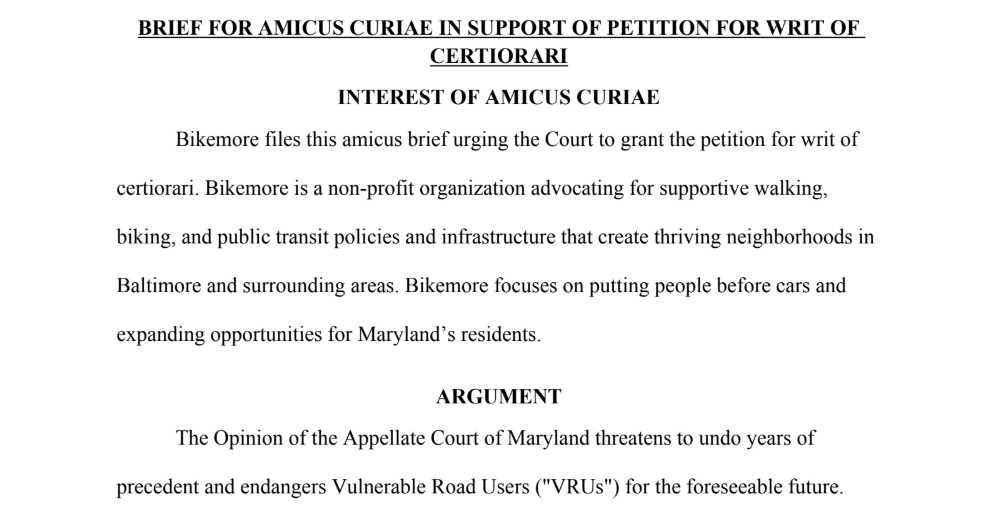Today, a video is making the rounds on the internet of a person on a bike being passed too closely by a Charm City Circulator bus. We are choosing to share and make our public comment here, as a local news outlet has already picked up the story. When Bikemore first learned of the video, we immediately alerted Baltimore City Department of Transportation that operates Charm City Circulator. We got an immediate response from the city notifying us that officials at Transdev, the contractor that operates the circulator and trains and employs the drivers, had been contacted. We are confident that both the City of Baltimore and Transdev are taking this incident seriously, and we look forward to receiving a full report of actions taken to ensure these type of incidents do not occur again.
As people who ride bikes in the city, getting passed too closely by a bus, whether it is a city operated Circulator, Maryland Transit Administration bus, or a college shuttle is a frequent occurrence. As bicyclists, we have full rights to the road, but in Maryland that means riding your bike as far to the right of the road as practicable, except in certain cases, including where lane widths are too narrow that it would be unsafe to share the lane with another vehicle side by side. Which incidentally, frequently creates a conflict between bicyclists riding closely to bus stops, and bus operators trying to meet their schedules and pick up and load passengers in a timely manner.
While Baltimore City and Maryland Transit Authority have taken major steps to ensure that people on bikes are accommodated and considered, there is still more work to be done. It is clear in the video, that despite being trained by Transdev on how to operate a bus safely, particularly around people on bikes, that the culture shift on an individual level required to ensure that all people in the roadways are treated with care still has a ways to go.
We know that not every driver operates this way, but given the pressures of on time performance, it is not surprising that some operators may become resentful when a person on a bike is traveling more slowly in the right lane and as a result feel pressure to make unsafe decisions.
At Bikemore, our hope is to continue to work with these agencies to ensure their training is up to date given the increased presence of people who bike on the roads. We believe that as a whole, these agencies recognize the value and necessity of these trainings, and are striving to ensure their drivers maintain a culture of safety.
But what we also see in the video is a complete misunderstanding of Maryland law by their employee. People who ride bikes have a right to operate in the roadway. And if, as a person operating a motor vehicle, you would like to pass them, it is the law that you are required to give them a minimum of three feet passing distance. While we work to educate all people who operate motor vehicles on roadways the proper ways to safely share the road with people who bike, it is the commercial drivers that should be held to a higher standard. They receive specialized training, and should exhibit a professional demeanor, especially in situations that the person driving may find inconvenient. The risks are real, and the consequences can be deadly. No amount of on time performance should supersede the value of a human life.
Roadway design solutions exist, and the City should work to implement these designs in corridors that contain both a high volume of bus routes and people on bikes. Transit agencies that train drivers should maintain that passing vulnerable road users safely takes priority over on time performance. As seen in this video, the person on the bike was able to very quickly catch up to the bus at a stop, which leads us to believe, that had the bus simply decelerated and waited for the person on a bike to pass the bus stop rather than pass them so closely, on time performance would not have been compromised and that both the passengers on the bus and the person on a bike would have been able to continue to travel safely and efficiently.
Somehow as people, a culture where we value our own ability to maintain high speeds on urban streets has trumped the safety of those with whom we share the road. That needs to change. And hopefully, as we move forward our network of professionally trained drivers that work in Baltimore can lead by example.
If you experience an instance of unsafe driving by an operator of Charm City Circulator bus, the city requests you report it via their website at charmcitycirculator.com or their customer service line 410.350.0456. Be sure to note the bus ID located on the front exterior panel of the bus on both the driver and passenger sides.
For MTA, please report to http://mta.maryland.gov/questions-compliments-or-suggestions. For MTA, it is easier to Identify the driver if you capture the Route, Time, and “Block Number” located on the front of the bus.






